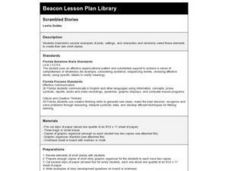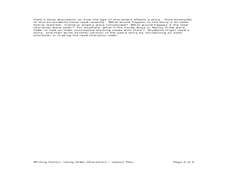Literacy Design Collaborative
Whom Do We Trust, and Why?
Is it possible to regain trust? Scholars put much thought into the subject of trust after reading Shakespeare's Macbeth. Readers work together to analyze how the character relationships develop the a message about trust. They then create...
EngageNY
Narrative Writing: Planning the Plot
You will never forget that moment. Scholars read a model narrative and analyze the moment a character became visible again. They compare the narrative to Okubo in Unbroken. Readers also assess the narrative essay according to a rubric...
EngageNY
Introducing Working Conditions in the Mills
Scholars discover how working in a textile mill in the nineteenth century affected the title character from Katherine Paterson's novel, Lyddie. Partners analyze quotes from the novel and then add evidence and questions about working...
Nemours KidsHealth
Conflict Resolution: Grades 9-12
Conflicts happen. Learning to deal with them positively, manage anger, and communicate feelings is the focus of a lesson that gives high schoolers the tools they need for conflict resolution. After reading a series of related articles,...
National Endowment for the Humanities
Narrative Voice in Moby Dick
Call him a reliable narrator! Ishmael is the focus of a lesson that asks readers to analyze the complex character of Herman Melville's narrator as he is introduced in the first chapter of Moby Dick.
Novelinks
The House on Mango Street: List-Group-Label
Encourage close reading of the text and a focus on how Sandra Cisneros' develops her characters with an activity that asks teams to sort, group, and label character descriptions from The House on Mango Street.
Curated OER
Patriots, Traitors, and Spies
Fifth graders determine how Nathan Hale and Benedict Arnold influenced the American Revolution. In this American Revolution instructional activity, 5th graders research primary and secondary sources to find three character traits of...
Curated OER
Enjoying the Adventure
Middle schoolers watch the video of "The Prince and the Pauper" and analyze, compare and contrast the characters. They write letters to a character from the point of view of another character and create a new ending to the play.
Curated OER
Scrambled Stories
Character development, setting, and plot? Sounds like the makings of a good narrative story. Young authors read and analyze several narrative examples, and then they use what they know to pen an original composition. They work both in...
Curated OER
To Kill A Mockingbird: Characterization
Students analyze several of the characters from "To Kill a Mockingbird". They view segments of the film, create character webs based on the most revealing film scenes, write journal entries and participate in class discussion.
Curated OER
Roll Of Thunder, Hear My Cry
Eighth graders read Roll of Thunder, Hear My Cry and participate in whole class discussions. They evaluate, analyze, and synthesize information in the text in order to explain character motivation and action. Students produce an essay...
E Reading Worksheets
Climax, Structure, and Elements of a Story
Appropriate for any short story, this worksheet asks readers to identify key elements and then analyze the structure of a short story.
Curated OER
Writing Fiction: Using Older Characters
Out with the old and in with the new? Not so in this lesson plan, which explores the idea of writing older characters in fiction. Students learn the value of varying their characters, exploring different perspectives, and avoiding...
Curated OER
Call of the Wild: After-reading Response Strategy
Readers select a character from Call of the Wild, record their responses to a series of prompts in a spiral notebook, and use details from the novel to support their thinking. The spirals are then used as source material to support a...
Curated OER
Literature Circles
Introduce how Literature Circles are formed in a classroom with this slide show. The slides go over each of the jobs that the students take on, such as: Discussion Director, Character Analyzer, Artful Artist, and Text Connector. After...
Southern Nevada Regional Professional Development Program
Common Core Reading Standards: Understanding Argument
What does your class know about logical fallacies? They can find out quite a bit and practice identifying logical fallacies if you follow the steps and use the resources provided here! After reviewing ethos, pathos, and logos, ask small...
Curated OER
Literary Analysis of Theme
Remember reading "The Lottery" and "The Possibility of Evil" by Shirley Jackson? Learners can experience and analyze the tension, themes, and human experience found in these pieces through reading and class discussion. They use...
Curated OER
Palms and Literature
Students read and analyze the Civil War novel, 'Charley Skedaddle.' They define key vocabulary terms, develop a story map, create a concept web for a character, and take vocabulary tests.
Curated OER
Bearstone: A Novel Analysis
Seventh graders need to be able to distinguish between major and minor characters and need to have read the novel Bearstone and be familiar with the sequence of events as well as the qualities displayed by each character over the course...
Curated OER
Creating Transitions
Fourth graders analyze the use of transitions in text. For this transitions lesson, 4th graders determine how and why a transition is used at a specific time in a piece of writing. They show transitions by using movements before...
Curated OER
Listen Up: Antigone Rising
Upper graders listen to and watch a documentary about an all female group Antigone Rising. They discuss how females are portrayed in the rock world, the type of music they play, their song lyrics, and what they note in the documentary....
Curated OER
The Purpose and Power of Persuasion
Examine the power of persuasion and have learners consider how it influences events in their own lives. After reading and analyzing informational texts to understand the author's purpose, class members take a written test and craft a...
Curated OER
Goldilocks Revisited
Second graders investigate the story of "The Three Bears" while focusing on the character of Goldilocks. They answer key questions that are focused upon the development of positive feelings and reactions. Students discuss the possible...
Curated OER
Creating and Using a Checklist of Performance Techniques to Critique and Find the "Message" in Mass Media Performances
Students analyze and critique theater events by evaluating and constructing meanings from improvised and scripted scenes and from theater, film, television, and electronic media productions.
Other popular searches
- Analyze Characterization
- Analyze Character Traits
- Analyze Characters
- Analyze Character Activities
- Analyze Character Plot
- Analyze Characters and Plot

























